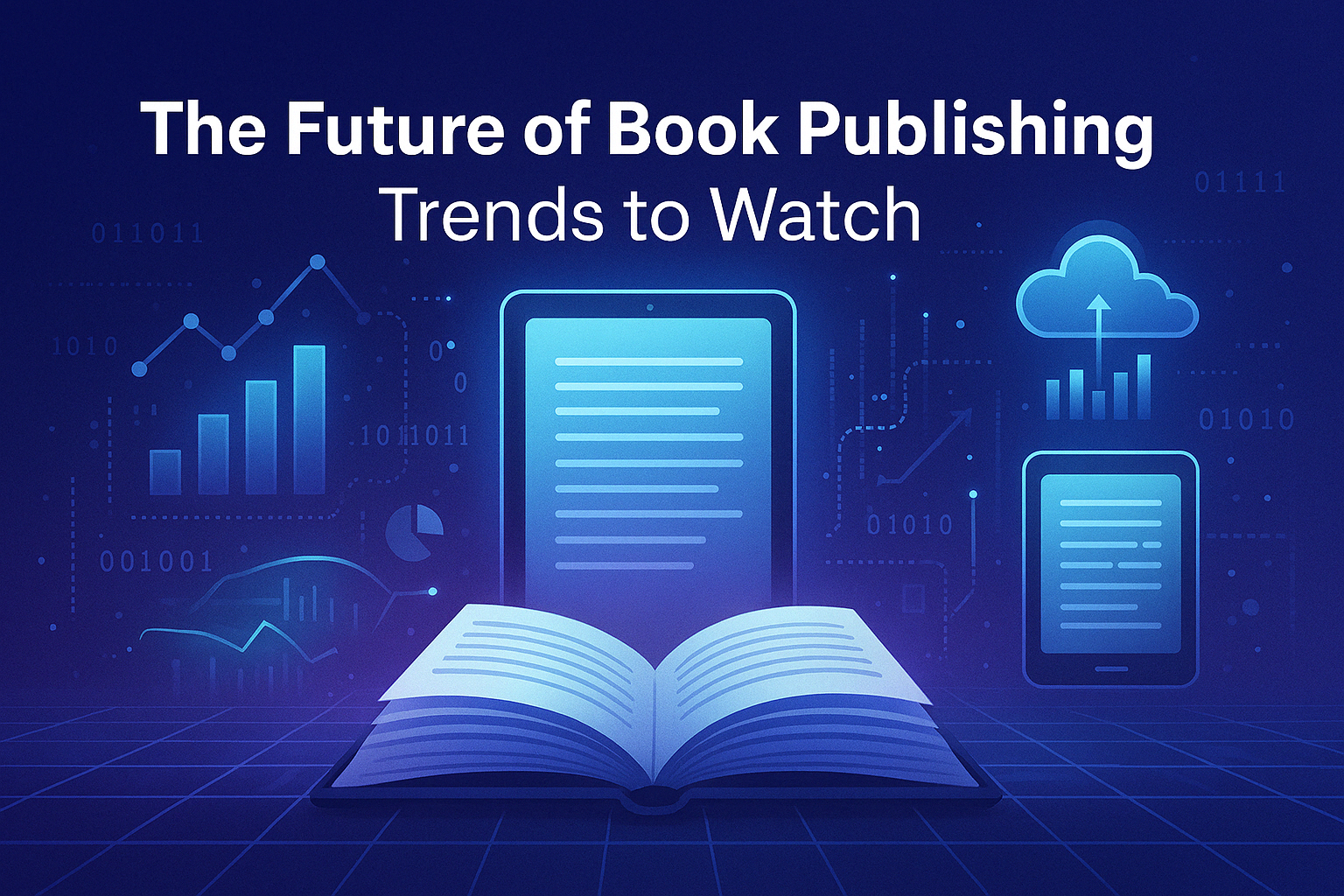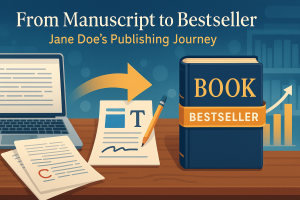Whether you’re an aspiring author, a seasoned publisher, or a reader passionate about the magic of storytelling, understanding the emerging trends in book publishing is essential. In this extensive guide, we’ll explore how technology, shifting reader behaviors, and innovative business models are reshaping the industry. From digital transformation and AI-powered tools to the self-publishing revolution and evolving marketing strategies, we’ll discover the trends that are setting the stage for the future of the book publishing world.
Staying informed about these trends will empower authors and publishers alike to adapt and thrive. Let’s examine the key trends, challenges, and opportunities that are paving the way for tomorrow’s publishing landscape.
1. The Evolution of Digital Publishing
Over the past decade, digital technology has transformed every aspect of our lives, and the world of book publishing is no exception. As e-books, audiobooks, and digital platforms become increasingly popular, the traditional print model is undergoing a profound evolution.
The Shift from Print to Digital Formats
The convenience and accessibility of digital formats have captured the interest of readers worldwide. With smart devices in nearly every home, e-readers and tablets have made it easier than ever to carry an entire library in your pocket. Digital publishing not only reduces production costs but also opens up global distribution channels that were once unimaginable.
This digital boom has also led many authors and publishers to explore new ways of engaging readers by incorporating multimedia elements, interactive content, and even virtual reality experiences. These innovations have the potential to create immersive reading experiences that go beyond traditional storytelling.
Benefits and Challenges of Digital Transformation
The benefits of digital publishing are clear—faster production cycles, reduced overhead, and the ability to update content in real-time. However, challenges remain. Protecting digital rights, managing piracy, and ensuring high-quality production standards are crucial aspects that both new entrants and industry veterans must address.
As the industry adapts to these changes, the role of traditional print is not disappearing but rather coexisting with digital formats in a dynamic and versatile market. The future of book publishing is a blend of innovative digital practices and time-tested storytelling traditions.
2. The Impact of Artificial Intelligence and Technology
One of the most exciting trends transforming book publishing is the integration of artificial intelligence (AI) and other cutting-edge technologies. AI is not only streamlining administrative tasks but also revolutionizing content creation, editing, and even marketing.
How Is AI Transforming Publishing?
AI-powered tools are emerging as indispensable assistants for authors and publishers. From predictive analytics that forecast reader preferences to automated proofreading and editing software, technology is helping streamline workflows and improve content quality. For instance, advanced algorithms can now analyze writing styles, detect inconsistencies, and suggest improvements—empowering writers to refine their work efficiently.
Learn more about these innovations by exploring how is AI transforming publishing.
Beyond Automation: Enhancing Creativity and Personalization
While automation is a significant benefit, AI is also creating opportunities for personalized reading experiences. Publishers can now use AI to tailor recommendations and build custom marketing strategies based on individual reader habits and preferences. This level of personalization not only increases engagement but also fosters a closer connection between authors and their audiences.
Technological advancements are bridging the gap between data analytics and creative content development, enabling publishers to predict market trends and adapt their strategies accordingly. As we move into a more data-driven era, leveraging AI will be crucial for those who want to remain competitive in the publishing world.
3. Traditional vs. Self-Publishing: A Changing Paradigm
The debate between traditional and self-publishing has taken on new dimensions in recent years. Both models have distinct advantages and challenges, and the decision ultimately depends on an author’s goals, resources, and desired level of creative control.
Pros and Cons for Self-Publishing and Traditional Publishing
Self-publishing offers unmatched creative freedom and the potential for higher royalties. Authors can take control of every aspect of their book—from cover design to marketing—without the constraints of traditional publishing houses. However, self-publishing also requires authors to assume roles traditionally handled by publishers, such as editing, distribution, and promotion. For a detailed comparison, check out the insightful piece on self-publishing vs traditional publishing pros and cons.
Conversely, traditional publishing provides a robust support system, including professional editing, design, and marketing resources. Working with established publishing houses can lend credibility and access to a broader distribution network. Nonetheless, the traditional route is often more competitive, and authors may have to compromise on creative decisions.
The Self-Publishing Revolution
With the advent of user-friendly digital tools and platforms, self-publishing has gained enormous traction. Many authors now choose self-publishing as a viable alternative to navigate the rapidly evolving literary landscape. This democratization of publishing means that anyone with a story to tell can now become a published author without needing a major publishing deal.
As both traditional and self-publishing models continue to evolve, hybrid models are emerging. These models combine the best aspects of both approaches, offering professional support while maintaining creative freedom. The future of book publishing lies in embracing this dynamic blend and creating flexible pathways that cater to diverse authorial needs.
4. The Role of Book Publishing Services
Book publishing services have become a critical component of the modern literary ecosystem. They provide essential support ranging from editing and design to marketing and distribution. These services are vital for authors seeking to produce high-quality content and reach the right audiences.
Professional Assistance for Successful Publishing
For many writers, partnering with specialized service providers is the key to turning a great manuscript into a polished, market-ready book. Engaging with reputable Book Publishing Services can offer the necessary expertise to navigate the complexities of the publishing process. Whether it’s refining your narrative, optimizing your layout, or strategizing your book launch, professional assistance ensures that every stage of the process is handled with precision and care.
Similarly, established Professional Book Publishers provide comprehensive solutions that add value to every aspect of the publishing journey. With their experience and industry knowledge, these service providers help authors achieve better visibility, enhanced credibility, and ultimately, more success in the marketplace.
Embracing a Full-Service Approach
A comprehensive approach to publishing that combines traditional methods with modern strategies is becoming increasingly popular. Book publishing services now offer end-to-end solutions that include not only editorial support but also digital marketing, distribution, and even analytics to gauge reader engagement. This holistic approach is critical in a world where the competition is fierce and reader preferences are constantly shifting.
5. Choosing the Right Publishing Partner
In a market awash with options, selecting the right publishing partner is of paramount importance. For many authors, the partnership they choose can significantly influence the success of their book.
Key Factors to Consider
When evaluating potential partners, consider the following:
- Track Record: Look for publishers with a proven history of successful book launches and sustained market presence.
- Services Offered: Evaluate whether the publisher provides a full suite of services, including editing, design, distribution, and marketing.
- Flexibility: The best partners offer flexible publishing models that can adapt to your specific needs.
For additional tips on navigating this critical choice, you can review our guide on how to choose the right book publishing service.
Establishing a Relationship Built on Trust
A successful partnership is built on trust and clear communication. It’s essential to work with partners who understand your vision and can help translate your ideas into a compelling finished product. Consider also exploring insights on finding a right publishing partner to ensure that you align with a team that shares your passion for storytelling and innovation.
6. Marketing Trends in the Book Publishing Industry
In today’s digital era, successful book marketing goes far beyond word-of-mouth recommendations. With readers spending more time online than ever before, innovative marketing strategies have become essential for reaching target audiences and driving sales.
Innovative Marketing Strategies for Authors
Effective marketing in the publishing industry involves a mix of traditional methods and new-age digital strategies. Social media, content marketing, influencer collaborations, and targeted advertising are just a few of the methods that authors can utilize to promote their work. Educating yourself on these methods can significantly enhance your book’s reach. For instance, discover comprehensive insights on how to market your own book to boost visibility and engagement.
The Role of Data and Analytics
Data-driven marketing is revolutionizing how authors connect with readers. By leveraging analytics, publishers can track audience behaviors, measure the success of marketing campaigns, and fine-tune their strategies in real time. Understanding which channels drive the most engagement ensures that marketing efforts are both efficient and effective.
Embracing Social Media and Community Building
Social media platforms have become indispensable in the marketing arsenal of modern publishers. They offer direct channels to engage with readers, share behind-the-scenes insights, and build loyal communities around a brand or a book. Virtual book tours, interactive Q&A sessions, and live readings are just some of the tactics that can enhance visibility in an ever-crowded digital space.
7. Diverse Voices and Emerging Narratives
One of the most exciting developments in the future of book publishing is the increasing emphasis on diversity. Readers are hungry for narratives that reflect a broad spectrum of experiences and perspectives, and publishers are responding by seeking out new voices and untold stories.
Celebrating Unique Stories and Underrepresented Authors
Diversity in literature is not just a trend—it’s a necessary evolution. By embracing stories from diverse backgrounds, publishers are enriching the cultural fabric of literature and providing readers with a wealth of perspectives. For inspiration, take a moment to explore discover the women book: a story of courage, which showcases the impactful narratives that emerge when diverse voices are given a platform.
The Emergence of New Literary Formats
In addition to traditional narratives, new literary formats such as graphic novels, interactive e-books, and serialized digital content are gaining traction. These formats appeal particularly to younger audiences, who seek innovative ways to consume stories. As technology continues to evolve, expect to see more experimental storytelling techniques that blend text, visuals, and multimedia elements.
Fostering Community and Collaboration
Publishing is becoming more collaborative, with writers, editors, and publishers increasingly working together to champion authentic storytelling. Communities that celebrate diversity not only support emerging voices but also foster a richer dialogue between creators and readers. This collaborative spirit is paving the way for a more inclusive and vibrant future in book publishing.
8. Self-Publishing: Empowering Authors for the Future
The rise of self-publishing has democratized the literary world, allowing anyone with a story to share it with the world. This movement is not merely a trend—it’s a revolution that has fundamentally altered how books are written, published, and distributed.
Benefits of Self-Publishing in a Digital Age
Self-publishing offers unparalleled creative control, higher royalty potential, and a streamlined path to market. With an array of digital platforms and tools available, authors can now bypass traditional gatekeepers and bring their work directly to readers. For guidance on this process, delve into how to self-publish a book, a resource that can help turn your manuscript into a best-selling product.
Overcoming the Challenges
While self-publishing presents many opportunities, it also requires a steep learning curve. From mastering marketing techniques to handling the logistics of distribution, authors must wear many hats. However, with determination and the right resources, self-published authors are increasingly proving that independent publishing can compete with traditional models on quality and impact.
Self-Publishing as a Catalyst for Innovation
The self-publishing trend is fostering a new breed of creative entrepreneurs. These authors are not only breaking traditional molds but also experimenting with innovative publishing formats and marketing strategies. By harnessing the power of digital tools and social media, self-published authors are shaping the future of the industry in exciting new ways.
9. Looking Ahead: Predictions for the Future of Book Publishing
As we look to the future, several key trends are poised to redefine book publishing. Here are some predictions and emerging innovations that could shape the next decade:
Augmented Reality (AR) and Virtual Reality (VR)
Imagine stepping into the world of your favorite book—exploring digital landscapes, interacting with characters, and experiencing stories in a wholly immersive way. AR and VR technologies are slowly but surely making this a reality. As these technologies mature, publishers may experiment with hybrid formats that blend traditional narrative forms with interactive digital experiences.
Blockchain and Digital Rights Management
Blockchain technology offers the promise of secure, transparent transactions and improved digital rights management. For authors and publishers alike, blockchain can help protect intellectual property, streamline royalty distribution, and provide a verifiable record of ownership and transactions. This technological integration could revolutionize the financial and legal aspects of book publishing in the near future.
More Personalized and Data-Driven Experiences
The future of publishing will be defined by personalization. As data analytics become more refined, publishers will be able to deliver highly targeted content recommendations, promotional offers, and reading experiences that cater to individual tastes. This approach not only enhances engagement but also builds stronger, data-informed relationships with readers.
Environmental and Ethical Considerations
In an era where sustainability is key, the publishing industry is also adapting to more eco-friendly practices. From using recycled materials in print production to adopting greener digital infrastructures, ethical considerations are becoming an integral part of the publishing process. This shift reflects a broader trend in consumer preferences and corporate responsibility.
Concluding Thoughts
The future of book publishing is an exciting frontier where tradition meets innovation. As digital technologies, AI, and self-publishing continue to reshape the industry, authors and publishers must remain agile, embracing change while preserving the art of storytelling.
By carefully balancing technological advancements with the timeless appeal of a well-crafted story, the next generation of publishing professionals can create a future where creativity and innovation go hand in hand. In this evolving landscape, the key to success lies in adaptability, collaboration, and a commitment to quality.
Authors and publishers who invest in understanding these trends will be better equipped to meet the challenges—and seize the opportunities—that the future of book publishing brings. From harnessing AI to revolutionize creative processes to embracing self-publishing as a means of democratizing literature, the choices we make today will shape the stories of tomorrow.
The journey ahead is full of potential, and the coming years promise to deliver even more transformative changes. As we continue to explore new formats, technologies, and business models, one thing remains certain: the power of storytelling endures, evolving to meet the needs of each new generation.









